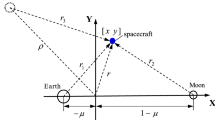Abstract
The distant retrograde orbits (DROs) can serve as the parking orbits for a long-term cis-lunar space station. This paper gives a comprehensive study on the transfer problem from DROs to Earth orbits, including low Earth orbits (LEOs), medium Earth orbits (MEOs), and geosynchronous orbits (GSOs), in the bicircular restricted four-body problem (BR4BP) via optimizations within a large solution space. The planar transfer problem is firstly solved by grid search and optimization techniques, and two types of transfer orbits, direct ones and low-energy ones, are both constructed. Then, the nonplanar transfer problem to Earth orbits with inclinations between 0 and 90 degrees are solved via sequential optimizations based on the planar transfers. The transfer characteristics in the cases of different destination orbit inclinations are discussed for both the direct and the low-energy transfer orbits. The important role of the lunar gravity in the low-energy transfers is also discussed, which can overcome the increase of transfer cost caused by the high inclination of Earth orbits. The distinct features of different transfer scenarios, including multiple revolutions around the Earth and Moon, the exterior phase, and the lunar flyby, are discovered. The energy of transfer orbits is exploited to discuss the effects of close lunar flybys. The results will be helpful for the transfer design in future manned or unmanned return missions, and can also provide valuable information for selecting proper parking DROs for cis-lunar space stations.
















Similar content being viewed by others
Data Availability
The data and material are available from the corresponding author upon reasonable request.
References
Betts, J.T.: Survey of numerical methods for trajectory optimization. J. Guid. Control Dyn. 21, 193–207 (1998)
Boudad, K., Howell, K., Davis, D.: Near rectilinear halo orbits in cislunar space within the context of the bicircular four-body problem. In: 2nd IAA/AAS SciTech Forum, Moscow, Russia (2019)
Broucke, R.A.: Periodic orbits in the restricted three body problem with Earth-Moon masses. Tech. Rep., Jet Propulsion Laboratory (1968)
Capdevila, L., Howell, K.: A transfer network linking Earth, Moon, and the triangular libration point regions in the Earth-Moon system. Adv. Space Res. 62(7), 1826–1852 (2018)
Capdevila, L., Guzzetti, D., Howell, K.: Various transfer options from Earth into distant retrograde orbits in the vicinity of the Moon. In: AAS/AIAA Space Flight Mechanics Meeting, p. 118 (2014)
Demeyer, J., Gurfil, P.: Transfer to distant retrograde orbits using manifold theory. J. Guid. Control Dyn. 30(5), 1261–1267 (2007)
Hénon, M.: Numerical exploration of the restricted problem, V. Astron. Astrophys. 1, 223–238 (1969)
Lara, M.: Design of distant retrograde orbits based on a higher order analytical solution. Acta Astronaut. 161, 562–578 (2019)
Markellos, V.V.: Numerical investigation of the planar restricted three-bodyproblem. Celest. Mech. 10(1), 87–134 (1974)
Oshima, K.: The use of vertical instability of L1 and L2 planar Lyapunov orbits for transfers from near rectilinear halo orbits to planar distant retrograde orbits in the Earth-Moon system. Celest. Mech. Dyn. Astron. 131(3), 14 (2019)
Oshima, K., Topputo, F., Yanao, T.: Low-energy transfers to the Moon with long transfer time. Celest. Mech. Dyn. Astron. 131(1), 4 (2019)
Qi, Y., Xu, S.: Mechanical analysis of lunar gravity assist in the Earth–Moon system. Astrophys. Space Sci. 360, 55 (2015)
Ren, J., Li, M., Zheng, J.: Families of transfers from the Moon to Distant Retrograde Orbits in cislunar space. Astrophys. Space Sci. 365, 1–21 (2020)
Scott, C., Spencer, D.: Calculating transfer families to periodic distant retrograde orbits using differential correction. J. Guid. Control Dyn. 33(5), 1592–1605 (2010)
Simó, C., Gómez, G., Jorba, Á., Masdemont, J.: The Bicircular Model Near the Triangular Libration Points of the RTBP. From Newton to Chaos. Plenum Press, New York (1995)
Singh, S.K., Anderson, B.D., Taheri, E., Junkins, J.L.: Low-thrust transfers to candidate near rectilinear halo orbits facilitated by Invariant Manifolds. In: AAS/AIAA Astrodynamics Specialist Virtual Lake Tahoe Conference (2020)
Topputo, F.: On optimal two-impulse Earth-Moon transfers in a four-body model. Celest. Mech. Dyn. Astron. 117, 279–313 (2013)
Topputo, F., Zhang, C.: Survey of direct transcription for low-thrust space trajectory optimization with applications. In: Abstract and Applied Analysis. Hindawi (2014)
Trofimov, S., Shirobokov, M., Tselousova, A., et al.: Transfers from near-rectilinear halo orbits to low-perilune orbits and the Moon’s surface. Acta Astron. 167, 260–271 (2020)
Vaquero, M., Howell, K.C.: Leveraging resonant-orbit manifolds to design transfers between libration-point orbits. J. Guid. Control Dyn. 37, 1143–1157 (2014)
Whitley, R., Martinez, R.: Options for staging orbits in cislunar space. In: 2016 IEEE Aerospace Conference, pp. 1–9. IEEE (2016)
Winter, O.C.: The stability evolution of a family of simply periodic lunar orbits. Planet. Space Sci. 48(1), 23–28 (2000)
Xu, M., Xu, S.: Exploration of distant retrograde orbits around Moon. Acta Astron. 65(5–6), 853–860 (2009)
Zhang, R., Wang, Y., Zhang, H., Zhang, C.: Transfers from distant retrograde orbits to low lunar orbits. Celest. Mech. Dyn. Astron. 132, 41 (2020)
Zimovan, E.M., Howell, K.C., Davis, D.C.: Near rectilinear halo orbits and their application in cis-lunar space. In: 3rd IAA Conference on Dynamics and Control of Space Systems, Moscow, Russia, p. 20 (2017)
Funding
This work was supported by the National Natural Science Foundation of China (Grant number 11872007), the Fundamental Research Funds for the Central Universities, and the Key Research Program of the Chinese Academy of Sciences (Grant number ZDRW-KT-2019-1-0102).
Author information
Authors and Affiliations
Corresponding author
Ethics declarations
Conflicts of interest/Competing interests
The authors have no conflicts of interest to declare that are relevant to the content of this article.
Additional information
Publisher’s Note
Springer Nature remains neutral with regard to jurisdictional claims in published maps and institutional affiliations.
Rights and permissions
About this article
Cite this article
Zhang, R., Wang, Y., Zhang, C. et al. The transfers from lunar DROs to Earth orbits via optimization in the four body problem. Astrophys Space Sci 366, 49 (2021). https://doi.org/10.1007/s10509-021-03955-1
Received:
Accepted:
Published:
DOI: https://doi.org/10.1007/s10509-021-03955-1




